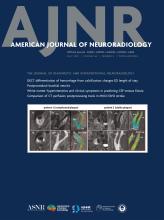Index by author
Brinjikji, Waleed
- NeurointerventionYou have accessStent Angioplasty for the Treatment of Cerebral Vasospasm: A Systematic Review and Meta-AnalysisJonathan Cortese, Esref Alperen Bayraktar, Sherief Ghozy, Armin Zarrintan, Cem Bilgin, Waleed Brinjikji, Ramanathan Kadirvel, Pervinder Bhogal and David F. KallmesAmerican Journal of Neuroradiology May 2025, 46 (5) 943-949; DOI: https://doi.org/10.3174/ajnr.A8617
- Spine Imaging and Spine Image-Guided InterventionsYou have accessAdditional Diagnostic Value of Conebeam CT Myelography Performed after Digital Subtraction Myelography for Detecting CSF-Venous FistulasAjay A. Madhavan, Niklas Lutzen, Jeremy K. Cutsforth-Gregory, Wouter I. Schievink, Michelle L. Kodet, Ian T. Mark, Pearse P. Morris, Steven A. Messina, John T. Wald and Waleed BrinjikjiAmerican Journal of Neuroradiology May 2025, 46 (5) 1044-1049; DOI: https://doi.org/10.3174/ajnr.A8535
Brugerolles, Paul
- NeurointerventionYou have accessPrepontine Cistern Filling Independently Predicts Poor Neurologic Outcomes in Ruptured PICA AneurysmsEtienne Lefevre, Paul Brugerolles, Kévin Premat, Stéphanie Lenck, Eimad Shotar, Alice Jacquens, Vincent Degos, Anne Laure Boch, Alexandre Carpentier, Frédéric Clarencon and Aurélien NouetAmerican Journal of Neuroradiology May 2025, 46 (5) 929-935; DOI: https://doi.org/10.3174/ajnr.A8615
Calabrese, Evan
- EDITOR'S CHOICEBrain Tumor ImagingYou have accessDevelopment and Evaluation of Automated Artificial Intelligence–Based Brain Tumor Response Assessment in Patients with GlioblastomaJikai Zhang, Dominic LaBella, Dylan Zhang, Jessica L. Houk, Jeffrey D. Rudie, Haotian Zou, Pranav Warman, Maciej A. Mazurowski and Evan CalabreseAmerican Journal of Neuroradiology May 2025, 46 (5) 990-998; DOI: https://doi.org/10.3174/ajnr.A8580
The goal of this study was to compare AI-based volumetric GBM MRI response assessment with standardized radiologist response assessments. The AI-based volumetric response assessment yielded overall moderate performance for recapitulating most human response assessment categories (BT-RADS 1, 2, and 4) but demonstrated the lowest performance for predicting BT-RADS 3, which is likely related to the high variability of this assessment. In comparison to radiologist assessment, the AI-based volumetric GBM MRI response assessment showed comparable performance for overall survival.
Callen, Andrew L.
- EDITOR'S CHOICESpine Imaging and Spine Image-Guided InterventionsYou have accessAssessing the Diagnostic Value of Brain White Matter Hyperintensities and Clinical Symptoms in Predicting the Detection of CSF-Venous Fistula in Patients with Suspected Spontaneous Intracranial HypotensionSamantha L. Pisani Petrucci, Nadya Andonov, Peter Lennarson, Marius Birlea, Chantal O’Brien, Danielle Wilhour, Abigail Anderson, Jeffrey L. Bennett and Andrew L. CallenAmerican Journal of Neuroradiology May 2025, 46 (5) 1036-1043; DOI: https://doi.org/10.3174/ajnr.A8548
The purpose of this retrospective cohort study was to assess the quantity and distribution pattern of WMH in patients with suspected SIH who underwent subsequent dynamic CTM. Patients with CVF had significantly higher Bern scores and significantly fewer WMH than those without CVF. Also, the migraine-type pattern of WMH was present at a nearly 4-fold greater frequency in the CVF- group versus the CVF+ group. Additionally, the symptom data demonstrated distinct clinical phenotypes between patients with CVF (eg, higher occurrence of a pressure-type or throbbing headache, symptoms worsening with the Valsalva maneuver) and those without CVF (eg, neck pain, fatigue, photophobia, and phonophobia).
Carlson, Matthew L.
- Head and Neck ImagingYou have accessInner Ear Signal Abnormalities of Adjacent Intracranial LipochoristomaJohn C. Benson, Matthew L. Carlson, Karl R. Khandalavala, Girish Bathla, Paul J. Farnsworth, Jamie J. Van Gompel, John T. Wald and John I. LaneAmerican Journal of Neuroradiology May 2025, 46 (5) 1016-1021; DOI: https://doi.org/10.3174/ajnr.A8603
Carpentier, Alexandre
- NeurointerventionYou have accessPrepontine Cistern Filling Independently Predicts Poor Neurologic Outcomes in Ruptured PICA AneurysmsEtienne Lefevre, Paul Brugerolles, Kévin Premat, Stéphanie Lenck, Eimad Shotar, Alice Jacquens, Vincent Degos, Anne Laure Boch, Alexandre Carpentier, Frédéric Clarencon and Aurélien NouetAmerican Journal of Neuroradiology May 2025, 46 (5) 929-935; DOI: https://doi.org/10.3174/ajnr.A8615
Cattin, Philippe Claude
- EDITOR'S CHOICENeurovascular/Stroke ImagingYou have accessA Comparative Study of CT Perfusion Postprocessing Tools in Medium/Distal Vessel Occlusion StrokeHelene Corbaz, Nikolaos Ntoulias, Alex Brehm, Julia Wolleb, Philippe Claude Cattin, Florentin Bieder, Victor Schulze-Zachau and Marios-Nikos PsychogiosAmerican Journal of Neuroradiology May 2025, 46 (5) 900-907; DOI: https://doi.org/10.3174/ajnr.A8616
This retrospective single-center cohort study investigated the discrepancy of 2 widely used postprocessing tools (Syngo.via and RapidAI) for CTP in patients with medium/distal vessel occlusion (MDVO) stroke. The 2 postprocessing tools were discordant on the volume and the location of perfusion deficit in isolated MDVO as well as the volume of potentially salvageable penumbra. As such, this questions whether infarct core size or penumbra volume should routinely be used to identify candidates for MDVO thrombectomy.
Cerron-vela, Carmen
- Pediatric NeuroimagingYou have accessCoronal Clival Cleft in CHARGE Syndrome: Fetal MRI SeriesSara Reis Teixeira, Carmen Cerron-Vela, Nahla Khalek, Renee Wright and Matthew T. WhiteheadAmerican Journal of Neuroradiology May 2025, 46 (5) 1022-1028; DOI: https://doi.org/10.3174/ajnr.A8609
Chaturvedi, Seemant
- FELLOWS' JOURNAL CLUBNeurovascular/Stroke ImagingYou have accessStroke Thrombectomy for Large Infarcts with Limited Penumbra: Systematic Review and Meta-Analysis of Randomized TrialsHuanwen Chen, Seemant Chaturvedi, Dheeraj Gandhi and Marco ColasurdoAmerican Journal of Neuroradiology May 2025, 46 (5) 915-920; DOI: https://doi.org/10.3174/ajnr.A8553
This meta-analysis evaluated randomized clinical trial results to provide more definitive guidance on the role of EVT for patients with stroke with large infarcts based on perfusion metrics. The results showed that the effectiveness of thrombectomy is uncertain regarding the safety and efficacy of thrombectomy for patients with limited areas of at-risk tissue. EVT may be beneficial for those with intermediate perfusion mismatch (ratio of 1.2-1.8 or volume of 10-15 mL) but not for those with low perfusion mismatch (ratio <1.2 or volume <10 mL).
Chen, Huanwen
- FELLOWS' JOURNAL CLUBNeurovascular/Stroke ImagingYou have accessStroke Thrombectomy for Large Infarcts with Limited Penumbra: Systematic Review and Meta-Analysis of Randomized TrialsHuanwen Chen, Seemant Chaturvedi, Dheeraj Gandhi and Marco ColasurdoAmerican Journal of Neuroradiology May 2025, 46 (5) 915-920; DOI: https://doi.org/10.3174/ajnr.A8553
This meta-analysis evaluated randomized clinical trial results to provide more definitive guidance on the role of EVT for patients with stroke with large infarcts based on perfusion metrics. The results showed that the effectiveness of thrombectomy is uncertain regarding the safety and efficacy of thrombectomy for patients with limited areas of at-risk tissue. EVT may be beneficial for those with intermediate perfusion mismatch (ratio of 1.2-1.8 or volume of 10-15 mL) but not for those with low perfusion mismatch (ratio <1.2 or volume <10 mL).








